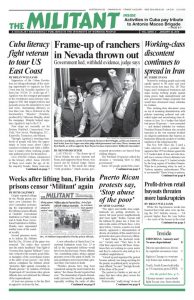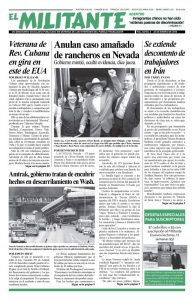While the big-business media has boasted that retail sales were up during the 2017 holiday season — 3.8 percent higher than the year before — the crisis of the bosses in the retail industry continues to unfold as growing numbers of U.S. retail and apparel companies face increasing debt, bankruptcy and competition.
Moody’s rating agency reports that 26 major U.S. retail companies are on their “distressed list” — that is, their “junk” rating puts them at risk of default or bankruptcy. The list surpasses levels reached during the recession a decade ago. And it includes a wide variety of well-known companies from high-end Neiman Marcus Group to Sears Holdings, the supermarket chain Fairway, General Nutrition Centers, Payless Shoes and 99 Cents Only Stores. All retail outlets face stiffening competition from behemoths Walmart and Amazon today. But the crisis in retail that Moody’s details is a product of something else — the effects of the capitalist bosses’ crisis of declining production and trade. Facing a long-term decline in profit rates, the propertied families see no point in putting their capital into expanding productive capacity and jobs. Instead, they speculate on various forms of commercial paper, seeking higher returns.
In the retail sector they’ve sought to make a profit through issuing bonds to finance highly leveraged buyouts. While generating short-term gains for investors, this gambit saddles the newly purchased retail chains with huge debts.
Part of the bet was that these outfits — many with a positive sales history — would continue to make money to service the debt. But recession conditions, coupled with heightened competition from the rise of Amazon and internet retail, has taken a toll.
According to the Dec. 29 Financial Times, “more than half of the largest leveraged retail buyouts completed since 2007 have either defaulted, gone bankrupt or are in distress.” Out of the 31 deals reviewed by the paper, 19 leveraged buyouts worth a combined $43 billion are “in trouble.”
“Over the next two years,” the paper said, “$68bn of US retail debt will fall due.”
In September Toys R Us, which has been in business for 70 years, declared bankruptcy. Private equity firms Bain Capital and KKR, and real estate group Vornado, took over ownership in a 2005 leveraged buyout, saddling the company with soaring debt levels.
In addition to Toys R Us, at least 50 other U.S. retailers filed for bankruptcy in 2017, the most in six years.
The hardest hit by the bankruptcy wave are the nearly 16 million workers employed in these stores. Growing numbers face job losses or cuts in hours, pay and benefits.
Nationwide, more than 5,000 retail store closures have been announced over the past year, including by Macy’s, Kohl’s, Kmart, J.C. Penney, Gap and Best Buy. Payless announced closure of about 500 of its shoe stores as it filed for bankruptcy.
Nearly $6 billion in high-yield retail debt is set to fall due in 2018.
Sears Holdings Corp., which owns both Sears and Kmart stores, lost $565 million during the first 10 months of 2017, bringing its cumulative losses since 2011 to $11 billion. At the beginning of 2017, the company’s long-term debt stood at $4.2 billion, twice as much as a year earlier. Company bosses gave up buying national TV ads during this year’s holiday season.

